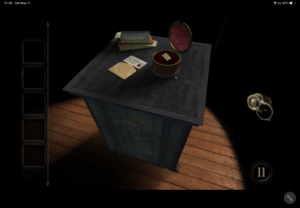Released in 2012 and developed by Fireproof Games, originally for IOS platforms, The Room (Pocket) is an online/video puzzle game featuring series of challenging puzzle boxes the user needs to solve to get tothe next level, which is the puzzle box hiding inside. The game is now accessible through multiple well-known online platforms and game consoles, such as Google Play and Nintendo Switch, addressing to an international audience of young adults and adults. The game’s lack of reliance on language helps transcend language barriers many mystery/puzzle narrative games get stuck on, and even though the challenges require critical thinking, there is no prior skill or knowledge exposure required to play the game, which also broadens the audience to include younger players as well. The game ha s limited player modes, and is designed for a single player, and therefore would not be appealing to audiences looking for group, family, or party games. Like Dear Esther, this game also leverages the solitude/isolation of the player to enhance the elements of tension and mystery weaved into the game’s atmosphere and mechanics. Yet, it is the mechanics of the puzzle that particularly make the game engaging for its audience. The Room’s use of its platform, not just to engage its young audience, but also to mimic realistic physical interaction with the puzzle box is unique. Through the abilities of the platform, such as the touchscreen for IOS devices, the Room enables the player to solve three dimensional puzzles by tilting/rotating the box, turning and activating keys, enabling more creative possibilities for both the challenges and the solutions. These unique possibilities make the game more engaging for the player. Therefore, as can be seen above, The Room leverages the mechanics of its puzzle(s) to create a more engaging and entertaining player experience through the aesthetics of challenge, sensation and discovery, and the formal elements of rules, boundaries, resources.
s limited player modes, and is designed for a single player, and therefore would not be appealing to audiences looking for group, family, or party games. Like Dear Esther, this game also leverages the solitude/isolation of the player to enhance the elements of tension and mystery weaved into the game’s atmosphere and mechanics. Yet, it is the mechanics of the puzzle that particularly make the game engaging for its audience. The Room’s use of its platform, not just to engage its young audience, but also to mimic realistic physical interaction with the puzzle box is unique. Through the abilities of the platform, such as the touchscreen for IOS devices, the Room enables the player to solve three dimensional puzzles by tilting/rotating the box, turning and activating keys, enabling more creative possibilities for both the challenges and the solutions. These unique possibilities make the game more engaging for the player. Therefore, as can be seen above, The Room leverages the mechanics of its puzzle(s) to create a more engaging and entertaining player experience through the aesthetics of challenge, sensation and discovery, and the formal elements of rules, boundaries, resources.
The Room is successful in finding the sweet spot of difficulty where the challenging nature of its puzzles keep the players intrigued and engaged throughout multiple tries and fails but doesn’t deter them or drive them away. The level of challenge slightly increases with each new puzzle box, but it always teeters on the edge of frustrating the players, motivating them to play more and marvel at how close they are to solving the challenge, and driving them away from the game. The three-dimensional aspect of the boxes, and the challenges presented on them appeal to the players’ sensual pleasure, making the game almost feel tactile, as if playing with a real puzzle cube. The sensual satisfaction keeps the players engaged, encouraging them to explore the shape, the boundaries, and the potential solutions. The aesthetic of discovery that arises from doing so leverages the players’ curiosity through the premise of increased possibilities enabled by this three-dimensional terrain/structure and sensual experiences. Unlike a 2D puzzle, the three-dimensionality of this puzzle is a resource that encourages the players to think creatively and imaginatively to come up with the solutions, making the game much more engaging and entertaining.
The lack of boundaries and clear rule descriptions compliment the overall aesthetic of discovery and the terrain in encouraging creativity, leading to more engaging plays. The player isn’t restricted by the game, and instead explores the limits of what they can and cannot do on each level, which forces them to engage more with the puzzle and gain a deeper understanding. It also helps mimic real, physical puzzle cubes where the player is left to explore the cube with no rules or explanations except for the rules of physics. The puzzles expect the player to leverage curiosity to learn the possible actions. As said actions, rules and boundaries evolve throughout different cubes, and the player needs to re-explore on each level, the puzzles preserve their novelty and keep challenging the player with similar mechanics (at the end of the day they are all puzzle boxes) without getting boring. Therefore, the game takes advantage of aesthetics, resources, rules, boundaries, and the player to keep being entertaining and engaging.



